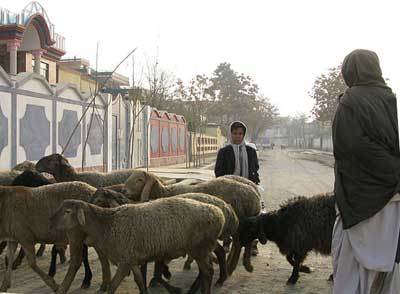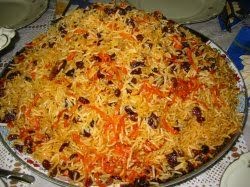At that time, family feasts, some of which I was invited to, were rarely attended by foreigners because the government frowned on it. Of course, I went anyway. The meal for such a celebration would consist of non flatbread, lamb kabobs—sometimes decorated with chile and also grilled, a rice dish, plus lots of strong, dark tea. Alcoholic drinks were banned because of the Islamic religion, and an Afghan caught imbibing could wind up in a cell too short to stretch out in and too low to stand up in. My favorite party dish was birinj Kabuli, Kabul rice, and we still eat it to this day. Made with rice, raisins, pine nuts, red chile and spices, it is tasty and healthy, and the recipe is included here.
 |
 |
| Afghani women preparing non. | Fat-tailed sheep. Photo by Colleen Taugher |
The bread, non, was the staple of the diet. It was made by mixing hard red winter wheat flour by hand with water. The dough was then flattened to about an eight-inch circle, an inch or so thick, put on a wooden paddle, and baked in a round-topped clay oven. The bread was solid, delightfully tasty, and no matter how long it was around, it seemed to be resistant to mold.
The only cooking fat was obtained from the tail of a special fat-tailed sheep that looked like any other of its relatives, except that its tail was eight to twelve inches wide. The butchers would render this fat at slaughtering time, and it was widely used in local cookery. It definitely had a strong, “muttony” taste, and I never learned to like it much.
The American government sent wheat, as there was never enough available, and the Russians built a modern bread bakery, which produced—of all things—a pumpernickel that I enjoyed. But the Afghans refused to eat it. Then the king, Zahir Shah, ordered that all government employees and members of the army had to take pumpernickel as part of their salary. This wasn’t very popular, and there was no audible dissent, but I think they probably fed it to their dogs.
In the 1980s, with Russian troops occupying the country, an effort was made to increase food crops, rice, and wheat by means of large community farms. There was some increase in production reported in the early 1980s, but the destruction of the farms during the fighting apparently led to a reduction in food supplies. But as I learned during my years there, Afghans are tough people and will survive the latest war that has ravished their country.
 Pilau Kabuli
Pilau Kabuli
(Chicken and Rice)
Chicken is not an everyday dish, as few are raised, and they are only served at very special meals. Parts can be used, or an entire chicken.
2 jalapeño or serrano chiles, stems removed, sliced into rings
4 pounds chicken, cut up
1 medium onion, chopped
3 cups cooked rice
2 medium onions, sliced thinly
1 tablespoon shortening
1 teaspoon ground cardamom
1 teaspoon ground cumin
3 medium carrots, cooked and thinly sliced
4 ounces seedless raisins
Place the chicken and chopped onion a large pot, cover with water. Bring to a boil, reduce heat, cover and simmer for at least an hour, until tender. Remove the chicken, allow it to cool, strain, and reserve the stock. Remove the meat from the bones and use only the larger pieces.
To prepare the sauce, brown the sliced onions in the shortening, remove from heat, then add the cardamom, cumin, and chile, and mash with the onions to form a puree. Add about 2 cups of the reserved chicken stock and mix well. Bring the mixture to a boil, reduce heat, and simmer for about 5 minutes. Taste and adjust the seasonings.
Combine the rice, stock sauce and chicken. Place in a greased casserole, put the carrots on top in a pattern, then spread the raisins over the top. Cover and cook in a moderate oven, 325 degrees F., for about 30 minutes. If the dish looks dry, add more stock. When finished, gently mix the carrots and raisins with the rice and chicken.
Serves: 6
Heat Scale: Medium
Saulan
(Vegetable and Rice Sauce)
This sauce is served over cooked rice or vegetable dishes. There is a lot of variety in each cook’s ingredients, so this is a widely used, basic sauce.
1 tablespoon chopped or minced fresh green or red chile, such as serrano or New Mexican
1 pound very lean boneless beef or lamb, cubed
1/2 cup shortening
1 medium onion, sliced
1 clove garlic, minced
1/4 teaspoon black pepper
1 cup water
1/4 cup dried peas or beans, soaked overnight
Lightly brown the cubed meat, onion and garlic in the shortening. Add the other ingredients and cook until the meat is tender.
Yield: 2 cups
Heat Scale: medium
Variation: Other fresh vegetables, such as eggplant, green peas, beans, or squash may be used in place of the dried peas or beans. They should be cut in small cubes, and after the meat is tender they can be added.





